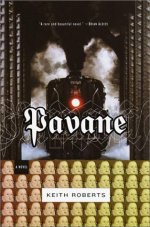|
Keith Roberts Keith Roberts was born in 1935 and he succumbed to pneumonia in October 2000. He is best know for Pavane (1968), a collection of linked stories set in an alternate world where Elizabeth I was assassinated and 20th century England remained technologically backward under the oppression of the Catholic Church. Other books include The Chalk Giants (1974), The Passing of the Dragons (collection - 1977), Molly Zero (1980), Kaeti and Company (1986) and Kiteworld (1985). In 1956 he graduated from Columbia University, with a major in Comparative Literature, and married Barbara Brown. After many sales, he earned a Hugo Award for his promise (the youngest person ever to do so). In the summer of 1955, he had moved into an apartment in New York where Randall Garrett, an established science fiction writer, lived next door; Harlan Ellison, another promising young novice, also lived in the building. Garrett introduced Silverberg to many of the prominent editors of the day, and the two collaborated on many projects, often using the name Robert Randall. He divorced his first wife in 1986 and married writer Karen Haber the following year. He now lives in the San Francisco area. |
| Pavane
Keith Roberts The shadows of two great AH novels of the 60s loom over the present-day offerings, both books with their ambition and success, and their moral centre, trivializing the current work. These are Philip K. Dick's The Man in the High Castle(1963), winner of the Hugo Award, and Keith Roberts' Pavane. They represent two of what I imagine are the three most popular branch points for AH: Dick's book is about a world in which the Allies lost World War II, and Roberts' book is about a world in which the Spanish Armada was not defeated, and Catholicism's influence was not diminished by Protestantism. (The third popular branch point, of course, is to have the South win the Civil War: and the significant early AH featuring that is Ward Moore's Bring the Jubilee.) Dick's novels of late are widely available, but the work of Roberts, who died last year, has long been hard to find. But now Orion via their SF Masterworks series and Del Rey, as part of their praiseworthy new Impact line of trade paperbacks, have reissued Pavane.
The mood overall is rather dark, though flashes of brightness and joy light the pages. Roberts' Catholic-dominated England, or Angle Land, is rather backwards technologically, as the Church carefully vets all scientific and technological knowledge, rejecting some advances and delaying others. Thus the opening measure, "The Lady Margaret," depicts a young man, Jesse Strange, who has just inherited his father's hauling business. But instead of internal combustion driven trucks, he uses steam engines pulling trains of wagons over roads (not rails). This is a chancy and dangerous but also romantic technology. Similarly, the second measure, "The Signaller," tells of a young man who dreams of becoming a member of the Guild of Signallers, who operate the network of semaphore towers that transmit messages across the land, in place of telephones or even telegraphs, given that electricity, though known, is banned. Roberts' detailed descriptions of both sorts of old-fashioned technology are intriguing and, as I said, rather romantic. At the same time it is clear that people are poorer and hungrier and fewer because of this retarded development -- but there is throughout an ambiguity about the depiction of this alternate present which is only intensified by Roberts' coda. Pavane is set at a time of subdued unrest -- the heavy hand of the Church on Angle Land is clearly resented, and this resentment is seen to spread throughout society as the book unfolds. The opening story deals with a prosperous and hardworking businessman, who must work with and around Churchly taxation and technological restrictions. That's a side issue to his personal story, though, as he takes his train on the last trip before winter closes the roads one year, worries about outlaws, and finds a reason to visit a barmaid he has long fancied, and also encounters an old school friend. Both meetings have momentous results, and change his life profoundly. "The Signaller" follows, a stark, sad, beautiful story of the title character's successful struggle to become a Signaller, and the violent fate that awaits him on his first solo assignment, as well as the mysterious person he encounters alone in the back woods. "Brother John" introduces us to a monk, an accomplished artist, who is radicalized when he is forced to record in his drawings the efforts of an "inquisitor" to torture the "truth" out of a crop of suspected sinners, and who almost by accident starts a grassroots rebellion. "Lords and Ladies" takes up with the Strange family again, as Jesse's niece, prosperous as a result of Jesse's hard work, meets a charismatic scion of the local noble family. This story shows the class structure of this alternate England effectively, and sets the scene, as it were, for the conclusion. But next is the mystical "The White Boat," in which a simple fishergirl becomes obsessed with the title vessel on its repeated visits to her home cove. Finally, in "Corfe Gate," Jesse Strange's great-niece, ruler of a castle, finds herself pushed to open resistance to the harsh rule of Rome, and with the help of her mysterious seneschal, John Faulkner, starts a country-wide rebellion, with bitter if ambiguous results. This remains a remarkable novel, beautifully written and unexpected in its working out. The characters come fully to life. The hints of mysterious elements working in the background add a special resonance to the book. The book asks interesting questions about the working out of history -- and if it suggests answers that a reader might not agree with, it does not compel agreement, but rather it compels thinking. It has been rightly regarded as a classic of our field from its first publication, and these new editions provide a fine occasion either to discover it for the first time, or to reread it once again. |
 Alternate
history is now one of the most popular sub-genres in the SF field, but
that popularity is a recent development. And the recent crop of
alternate history stories, enjoyable as some of them may be, seem
largely minor works, often overly concerned either with playing silly
games (either "identify the change point" or "spot the historical
character in a different role"), or with rewriting history to either
rectify a past mistake or warn of a danger averted.
Alternate
history is now one of the most popular sub-genres in the SF field, but
that popularity is a recent development. And the recent crop of
alternate history stories, enjoyable as some of them may be, seem
largely minor works, often overly concerned either with playing silly
games (either "identify the change point" or "spot the historical
character in a different role"), or with rewriting history to either
rectify a past mistake or warn of a danger averted.
 This
novel is composed of a brief prologue, indicating the "branch point,"
followed by six "measures," novelette- or novella-length sections,
beginning in 1968 and carrying the story forward several decades. Each
measure is a self-contained story, but there are also links between
them, particularly three stories which follow three generations of the
Strange family. Finally, a Coda serves to cast the entire story in a
somewhat different light -- for one thing, technically removing it
from the strict "Alternate History" subgenre, and also commenting on
the central conflicts of the story.
This
novel is composed of a brief prologue, indicating the "branch point,"
followed by six "measures," novelette- or novella-length sections,
beginning in 1968 and carrying the story forward several decades. Each
measure is a self-contained story, but there are also links between
them, particularly three stories which follow three generations of the
Strange family. Finally, a Coda serves to cast the entire story in a
somewhat different light -- for one thing, technically removing it
from the strict "Alternate History" subgenre, and also commenting on
the central conflicts of the story.